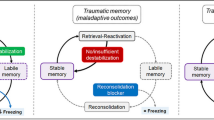Abstract—We have previously shown that acquisition of a conditioned fear response (the fear formation model) is accompanied by an increase in the level of extracellular serotonin in the medial prefrontal cortex enhancing future fear generalization. The aim of this work was to investigate the possible contribution of NO-serotonin interaction in this regulation. In vivo microdialysis in Sprague–Dawley rats showed that the infusion of the NO donor diethylamine nonoate (1 mM) into the medial prefrontal cortex via dialysis increased the level of extracellular serotonin in this area during the first 30 minutes of infusion followed by its gradual decrease. This treatment prevented the increase in the level of extracellular serotonin in the medial prefrontal cortex caused by acquisition of a conditioned fear response (a paired presentation of a conditioned auditory cue (CS+) and inescapable footshock) and after 24 h led to a decrease in animal freezing in response to a differential auditory cue (CS–) not associated with footshock (a measure of generalized fear) without affecting the level of freezing in the same animals in response to the conditioned cue (CS+) previously paired with footshock (a measure of conditioned fear). The data indicate that during the conditioned fear response acquisition, nitrergic signals in the medial prefrontal cortex inhibit the functional activation of the serotonin system reducing its contribution to generalized fear formation.





Similar content being viewed by others
REFERNCES
Arnsten, A.F., Raskind, M.A., Taylor, F.B., and Connor, D.F., Neurobiol. Stress, 2015, vol. 1, pp. 89–99.
Rozeske, R.R., Valerio, S., Chaudun, F., and Herry, C., Genes Brain Behav., 2015, vol. 14, no. 1, pp. 22–36.
Saul’skaya, N.B., Usp. Fiziol. Nauk, 2018, vol. 49, no. 4, pp. 12–29.
Xu, W. and Sudhof, T.C., Science, 2013, vol. 339, no. 6125, pp. 1290–1295.
Rozeske, R.R., Jercog, D., Karalis, N., Chaudun, F., Khoder, S., Girard, D., Winke, N., and Herry, C., Neuron, 2018, vol. 97, no. 4, pp. 898–910.
Kaczkurkin, A.N., Burton, P.C., Chazin, S.M., Manbeck, A.B., Espenses-Sturges, T., Cooper, S.E., Sponheim, S.R., and Lissek, S., Am. J. Psychiatry, 2017, vol. 174, no. 2, pp. 125–134.
Vieira, P.A., Corches, A., Lovelace, J.W., Westbrook, K.B., Mendoza, M., and Korzus, E., Neurobiol. Learn. Mem., 2015, vol. 119, pp. 52–62.
Bayer, H. and Bertoglio, L.J., Sci. Report, 2020, vol. 10.
Saul’skaya, N.B. and Marchuk, O.E., Ross. Fiziol. Zhurn., 2018, vol. 104, no. 4, pp. 466–476.
Saul’skaya, N.B. and Marchuk, O.E., Zhurn. Vyssh. Nervn. Deyat. im. I.P. Pavlova, 2019, vol. 69, no. 3, pp. 342–352.
Saul’skaya, N.B. and Marchuk, O.E., Ross. Fiziol. Zhurn., 2020, vol. 106, no. 12, pp. 1541–1552.
Saul’skaya, N.B. and Sudorgina, P.V., Zhurn. Vyssh. Nervn. Deyat. im. I.P. Pavlova, 2015, vol. 65, no. 3, pp. 372–381.
Ghasemi, M., Claunch, J., and Niu, K., Progress in Neurobiology, 2019, vol. 173, pp. 54–97.
Zhou, Q.G., Zhu, X.H., Nemes, A.D., and Zhu, D.Y., IBRO Reports, 2018, vol. 5, pp. 116–132.
Maximino, C., Lima, M.G., Batista, E.J.O., Oliveira, R.R.H.M., and Herculano, A.M., Neurosci. Let., 2015, vol. 588, pp. 54–56.
Chiavegatto, S., Dawson, V.L., Mamounasi, L.A., Koliatsos, V.E., Dawson, T.M., and Nelson, R.J., Proc. Natl. Acad. Sci. USA, 2001, vol. 98, no. 3, pp. 1277–1281.
Pavesi, E., Heldt, S.A., and Fletcher, M.L., Learn. Mem., 2013, vol. 20, no. 9, pp. 482–490.
Saul’skaya, N.B., Marchuk, O.E., Puzanova, M.A., and Trofimova, N.A., Neurochem. J., 2020, vol. 14, pp. 408–414.
Karolewicz, B., Paul, I.A., and Antkiewicz-Michaluk, L., Pol. J. Pharmacol., 2001, vol. 53, no. 6, pp. 587–596.
Dunn, A.J., Neurochem. Int., 1998, vol. 33, no. 6, pp. 551–557.
Smith, J.C.E. and Whitton, P.S., Neurosci. Let., 2000, vol. 291, no. 1, pp. 5–8.
Lu, Y., Simpson, K.L., Weaver, K.J., and Lin, R.C.S., Anat. Rec. (Hoboken), 2010, vol. 293, no. 11, pp. 1954–1965.
Kaehler, S.T., Singewald, N., Sinner, C., and Philippu, A., Brain Res., 1999, vol. 835, no. 2, pp. 346–349.
Vila-Verde, C., Marinho, A.L., and Guimaraes, F.S., Neurosci., 2016, vol. 320, no. 1, pp. 30–42.
Resstel, L.B., Correa, F.M., and Guimaraes, F.S., Cereb. Cortex, 2008, vol. 18, no. 9, pp. 2027–2035.
Saul’skaya, N.B. and Sudorgina, P.V., Ross. Fiziol. Zhurn., 2016, no. 10, pp. 1165–1175.
Funding
The study was conducted with no external support.
Author information
Authors and Affiliations
Corresponding author
Ethics declarations
Conflict of interests. The authors declare no conflict of interests.
Ethical approval. The study was conducted in compliance with international, national, and/or institutional principles of care and use of laboratory animals.
Rights and permissions
About this article
Cite this article
Saulskaya, N.B., Burmakina, M.A. & Trofimova, N.A. Nitric Oxide Inhibits the Functional Activation of the Medial Prefrontal Cortex Serotonin System during Fear Formation and Decreases Fear Generalization. Neurochem. J. 15, 266–272 (2021). https://doi.org/10.1134/S1819712421030107
Received:
Revised:
Accepted:
Published:
Issue Date:
DOI: https://doi.org/10.1134/S1819712421030107




